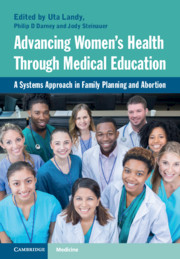 Advancing Women's Health Through Medical Education
Advancing Women's Health Through Medical Education from Section IV - Reproductive Health Services & Abortion Training: Global Examples
Published online by Cambridge University Press: 30 July 2021
Abortion has been legal in England, Scotland and Wales since 1967 when the Abortion Act was passed. The Act did not extend to Northern Ireland and abortion there has been highly restricted. Around 200,000 abortions are performed in Britain each year. In law, only doctors may authorize or perform abortions, but aspects of care can be delegated to other members of a healthcare team. Nearly three-quarters of abortions in the country are undertaken medically, a service mainly delivered by nurses and midwives. There are learning outcomes for abortion care in undergraduate medical education curricula and for post-graduate training in obstetrics and gynecology and community sexual and reproductive health care. However, a waning sense of responsibility by gynecologists to provide abortion care and, in England, a shift of abortion services away from National Health Service hospitals where training occurs to independent clinics, has resulted in fewer opportunities for practical exposure, role-modeling and mentorship. Formal education in abortion care for nurses and midwives is limited; most undertake professional development while working in an abortion service. Medical, nursing and midwifery colleges throughout the United Kingdom are actively working on improving the status of education in abortion care.
To save this book to your Kindle, first ensure [email protected] is added to your Approved Personal Document E-mail List under your Personal Document Settings on the Manage Your Content and Devices page of your Amazon account. Then enter the ‘name’ part of your Kindle email address below. Find out more about saving to your Kindle.
Note you can select to save to either the @free.kindle.com or @kindle.com variations. ‘@free.kindle.com’ emails are free but can only be saved to your device when it is connected to wi-fi. ‘@kindle.com’ emails can be delivered even when you are not connected to wi-fi, but note that service fees apply.
Find out more about the Kindle Personal Document Service.
To save content items to your account, please confirm that you agree to abide by our usage policies. If this is the first time you use this feature, you will be asked to authorise Cambridge Core to connect with your account. Find out more about saving content to Dropbox.
To save content items to your account, please confirm that you agree to abide by our usage policies. If this is the first time you use this feature, you will be asked to authorise Cambridge Core to connect with your account. Find out more about saving content to Google Drive.